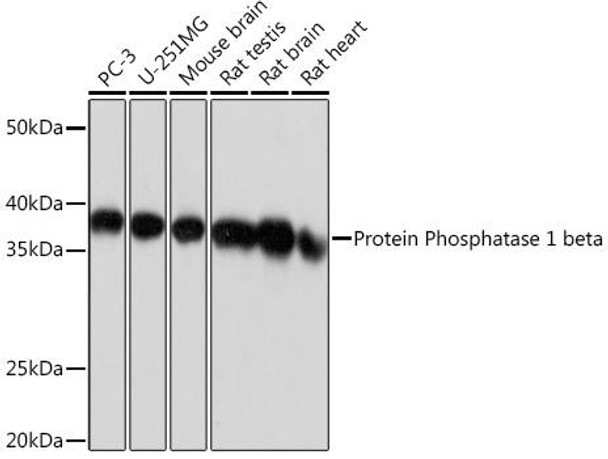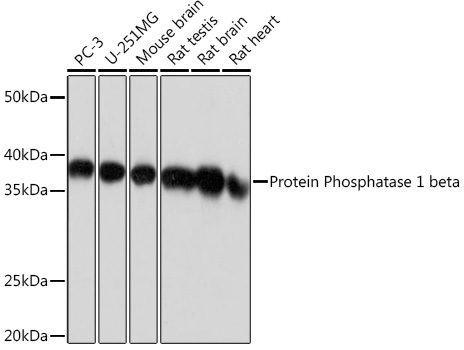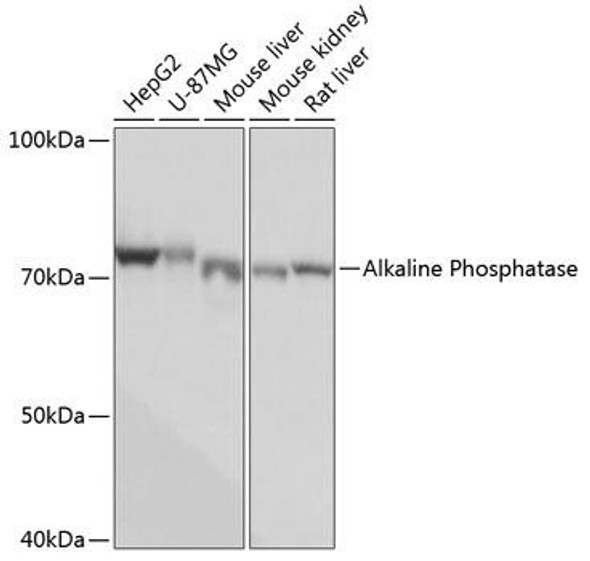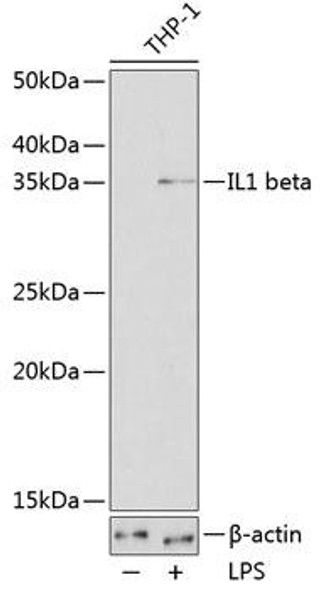Cell Biology Antibodies 17
Anti-Protein Phosphatase 1 beta Antibody (CAB4364)
- SKU:
- CAB4364
- Product Type:
- Antibody
- Reactivity:
- Human
- Reactivity:
- Mouse
- Reactivity:
- Rat
- Host Species:
- Rabbit
- Isotype:
- IgG
- Research Area:
- Cell Biology
Description
| Antibody Name: | Anti-Protein Phosphatase 1 beta Antibody |
| Antibody SKU: | CAB4364 |
| Antibody Size: | 20uL, 50uL, 100uL |
| Application: | WB IHC IF |
| Reactivity: | Human, Mouse, Rat |
| Host Species: | Rabbit |
| Immunogen: | A synthesized peptide derived from human Protein Phosphatase 1 beta |
| Application: | WB IHC IF |
| Recommended Dilution: | WB 1:500 - 1:2000 IHC 1:50 - 1:200 IF 1:50 - 1:200 |
| Reactivity: | Human, Mouse, Rat |
| Positive Samples: | PC-3, U-251MG, Mouse brain, Rat testis, Rat brain, Rat heart |
| Immunogen: | A synthesized peptide derived from human Protein Phosphatase 1 beta |
| Purification Method: | Affinity purification |
| Storage Buffer: | Store at -20'C. Avoid freeze / thaw cycles. Buffer: PBS with 0.02% sodium azide, 0.05% BSA, 50% glycerol, pH7.3. |
| Isotype: | IgG |
| Sequence: | Email for sequence |
| Gene ID: | 5500 |
| Uniprot: | P62140 |
| Cellular Location: | |
| Calculated MW: | 37kDa |
| Observed MW: | 37KDa |
| Synonyms: | HEL-S-80p, PP-1B, PP1B, PP1beta, PPP1CD |
| Background: | The protein encoded by this gene is one of the three catalytic subunits of protein phosphatase 1 (PP1). PP1 is a serine/threonine specific protein phosphatase known to be involved in the regulation of a variety of cellular processes, such as cell division, glycogen metabolism, muscle contractility, protein synthesis, and HIV-1 viral transcription. Mouse studies suggest that PP1 functions as a suppressor of learning and memory. Two alternatively spliced transcript variants encoding distinct isoforms have been observed. [provided by RefSeq, Jul 2008] |
| UniProt Protein Function: | PPP1CB: is a catalytic subunit of protein phosphatase 1 (PP1), a ubiquitous cytosolic serine-threonine phosphatase. Composed a catalytic subunit (PPP1CA, PPP1CB or PPP1CC) which is folded into its native form by inhibitor 2 and glycogen synthetase kinase 3, and then complexed to one or several targeting (or regulatory) subunits: PPP1R12A and PPP1R12B mediate binding to myosin; PPP1R3A, PPP1R3B, PPP1R3C and PPP1R3D mediate binding to glycogen; and PPP1R15A and PPP1R15B mediate binding to EIF2S1. PP1 is essential for cell division, plays critical roles in many cellular processes including glycogen metabolism, muscle contractility and protein synthesis, and is involved in the regulation of ionic conductances and long-term synaptic plasticity. Inhibits the synthesis of proteins involved in synaptic plasticity. Binds to the transcription factor cyclic AMP-dependent response element binding (CREB) and dephosphorylates it. May regulate chromatin condensation through regulation of histone H3 phosphorylation. Differentially expressed in gastric cancer. May participate in the neurodegenerative progress in Alzheimer's disease. Down-regulated in lung squamous cell carcinoma. |
| UniProt Protein Details: | Protein type:Nucleolus; Motility/polarity/chemotaxis; EC 3.1.3.16; EC 3.1.3.53; Protein phosphatase, Ser/Thr (non-receptor) Chromosomal Location of Human Ortholog: 2p23 Cellular Component: nucleoplasm; focal adhesion; glycogen granule; nucleolus; protein phosphatase type 1 complex; nucleus Molecular Function:protein binding; myosin-light-chain-phosphatase activity; metal ion binding; phosphoric monoester hydrolase activity; myosin phosphatase activity; protein kinase binding Biological Process: regulation of cell adhesion; glycogen metabolic process; regulation of glycogen biosynthetic process; protein amino acid dephosphorylation; regulation of circadian rhythm; entrainment of circadian clock by photoperiod; regulation of glycogen catabolic process; cell division; transforming growth factor beta receptor signaling pathway; triacylglycerol catabolic process; circadian regulation of gene expression; mitotic cell cycle; G2/M transition of mitotic cell cycle; negative regulation of transforming growth factor beta receptor signaling pathway |
| NCBI Summary: | The protein encoded by this gene is one of the three catalytic subunits of protein phosphatase 1 (PP1). PP1 is a serine/threonine specific protein phosphatase known to be involved in the regulation of a variety of cellular processes, such as cell division, glycogen metabolism, muscle contractility, protein synthesis, and HIV-1 viral transcription. Mouse studies suggest that PP1 functions as a suppressor of learning and memory. Two alternatively spliced transcript variants encoding distinct isoforms have been observed. [provided by RefSeq, Jul 2008] |
| UniProt Code: | P62140 |
| NCBI GenInfo Identifier: | 49065814 |
| NCBI Gene ID: | 5500 |
| NCBI Accession: | P62140.3 |
| UniProt Secondary Accession: | P62140,P37140, Q5U087, Q6FG45, B2R5V4, D6W565, |
| UniProt Related Accession: | P62140 |
| Molecular Weight: | 327 |
| NCBI Full Name: | Serine/threonine-protein phosphatase PP1-beta catalytic subunit |
| NCBI Synonym Full Names: | protein phosphatase 1, catalytic subunit, beta isozyme |
| NCBI Official Symbol: | PPP1CB |
| NCBI Official Synonym Symbols: | PP1B; PP-1B; PPP1CD; PP1beta; HEL-S-80p |
| NCBI Protein Information: | serine/threonine-protein phosphatase PP1-beta catalytic subunit; protein phosphatase 1-beta; protein phosphatase 1-delta; epididymis secretory sperm binding protein Li 80p; protein phosphatase 1, catalytic subunit, beta isoform; protein phosphatase 1, cat |
| UniProt Protein Name: | Serine/threonine-protein phosphatase PP1-beta catalytic subunit |
| UniProt Gene Name: | PPP1CB |
| UniProt Entry Name: | PP1B_HUMAN |







